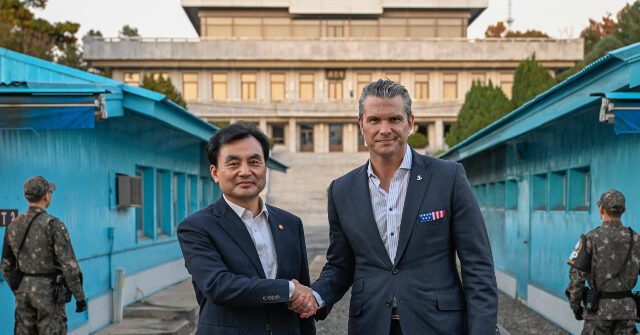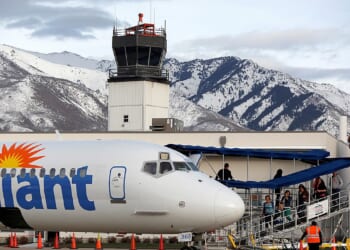Secretary of War Pete Hegseth met with South Korean Defense Minister Ahn Gyu-back on Monday at the demilitarized zone (DMZ), the heavily-defended border between North and South Korea.
Ahn said Hegseth’s visit to the DMZ had “symbolic and declarative significance” because it demonstrated “the strength of the South Korea-U.S. alliance and the combined defense posture.”
Hegseth is the first U.S. defense secretary to visit the DMZ in the past eight years. His itinerary included meeting with American and South Korean forces stationed along the border.
The DMZ, which is roughly 150 miles long and 2.5 miles wide, includes a small parcel of neutral territory near the village of Panmunjom called the Joint Security Area (JSA). The JSA is where President Donald Trump met with North Korean dictator Kim Jong-un in June 2019. Trump took a few historic steps over the demarcation line into North Korean territory during that meeting.
Panmunjom is normally a tourist attraction for South Koreans, but the tours were suspended last month when President Trump made the first visit to South Korea of his second term, because there was speculation Trump and Kim might once again meet in the JSA. The meeting did not come to pass.
The South Korean side of the DMZ is patrolled mainly by South Korean forces, but there is also a contingent of U.S. and United Nations forces known as the U.N. Command Security Battalion – Joint Security Area (UNCSB-JSA) providing security around the JSA.
Hegseth and Ahn are scheduled to hold an annual bilateral conference called the Security Consultative Meeting on Tuesday. The conference is a discussion of joint U.S. and South Korean efforts to defend against North Korean conventional, nuclear, and cyber threats.
A major topic on the agenda for this year’s meeting will be the Trump administration’s desire to make the American force in South Korea more “flexible,” meaning the force would be able to respond to other threats in Asia, such as a potential Chinese invasion of Taiwan.
The administration wants South Korea to budget more for defense and increase its military capabilities, so it would become less reliant on American forces. To that end, South Korea is preparing an 8.2 percent increase in defense spending for next year’s budget, with an emphasis on developing increased drone and cyber protection.
South Korea’s Yonhap News reported that Ahn and Hegseth will discuss the transfer of wartime operational control (OPCON) of regional forces from Washington to Seoul. South Korea gave wartime operational control to the United States during the 1950-1953 Korean War, and has yet to reclaim it, although peacetime OPCON reverted to Seoul in 1994.
South Korea’s current president, Lee Jae-myung, has expressed hopes of completing the wartime OPCON transfer before his term of office ends in 2030. South Korea’s increased defense spending will doubtless form part of his case for expediting the process.
South Korea’s Joint Chiefs of Staff Chairman, Gen. Jin Yong-sung, also met with his American counterpart, Gen. Dan Caine, on Monday. The two oversaw a first-of-its-kind combined formation flight above the U.S. military base in Pyeongtaek by American and South Korean fighter jets.
“Both leaders shared the assessment that the security environment in the Indo-Pacific has become increasingly complex due to advanced nuclear and missile threats posed by the Democratic People’s Republic of Korea (DPRK) and the intensifying global arms competition,” a statement on Monday from the U.S. Joint Chiefs of Staff (JCS) said.
Jin and Caine were concerned about the DPRK’s quest for advanced military technology through its growing partnership with Russia, but they expressed confidence that close coordination between U.S. and South Korean forces could keep North Korea in check.
















